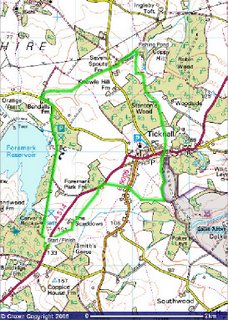- Walked: 6th April 2007
- Distance: 6.7m
- Terrain: 90m ascent over 3 miles and the same descent
- Summary: Walk through Dimminsdale Nature Reserve, South Wood, Ashby by-pass, back to start along Ivanhoe Way
- Time: 2.5 hours start to finish
The objects of the exercise tonight, other than the usual training and familiarisation for the Ivanhoe Way, were to capture some bluebells on film (or CCD, I guess) and to see if I could spot some Hawthorn in early flower. There are a number of places where the 'carpet of blue' effect is apparent at this time of the year, but I couldn't remember exactly where my best chances were. Therefore I set off on the route below in fading light and with my fingers crossed.
Very close to the Dimminsdale Reserve is a convenient car park. Just before walking into the woods, you get this lovely view of the bottom of Staunton Harrold Reservoir.

Even though the half-way point of this route is close to my house, I drove out to this point in order to get (I thought) the best chance of seeing Bluebells while the light was still good. Unfortunately, the nature reserve didn't yield great numbers of bluebells, there were plenty of other lovely things to see such as wild garlic in flower, and lots of blossom.

South Wood is a route between Ashby and Staunton Harrold which is popular with walkers and runners. I first spotted these curious 'albino' bluebells!

And Bingo, here I found the carpet of blue that I was looking for:


After emerging from the wood, and crossing a couple of fields, we meet the Ashby by-pass. This road was very good for the town, taking the heavy through traffic from the town centre. It cuts through some of the most beautiful countryside in the area, and so walking alongside it is a bitter-sweet experience - you have the unsightly tarmac and traffic noise, but it does afford some of the longest and most beautiful views.

And here's the money-shot! it was here that I saw hawthorne in flower. This picture was taken on 26 April 2007.

I have a clear memory of my maternal grandmother telling me that her two christian names, Violet and May, were both the names of flowers. She explained that May was a flower which grows on hedgerows. I now know that it's another name for the Hawthorn flower, which is so named because it appears in May. She wouldn't have known at the time that thirty years on, we would be citing the early appearance of these flowers as a symptom of the fact that the very planet we live on is being screwed up by vast overpopulation and the tendency for people to jump onto aeroplanes as if it were a bus ride.
This walk then picks up the Ivanhoe Way which goes all the way back to Dimminsdale. I love this part of the Ivanhoe Way, possibly largely because it's a very long downhill, but partly because it's very beautiful. As planned so far, my Ivanhoe Way attempt would bring me along this path in the opposite direction at the very end of the 36 miles. I considered whether I really wanted to finish the walk in this way, and have decided to reverse my original plan and walk the route in the opposite direction (ie the direction that Rog considers the correct direction). This new plan means that I'd start my attempt on the long walk with this long downhill and its lovely view, and take in Dimminsdale in the early morning.


The route above was generated using Meander.
Image produced from the Ordnance Survey Get-a-map service. Image reproduced with kind permission of Ordnance Survey and Ordnance Survey of Northern Ireland.








































